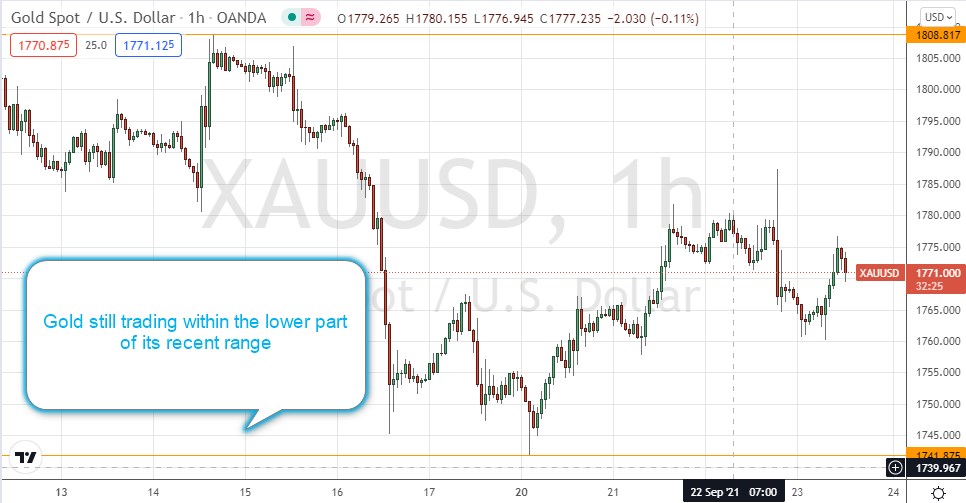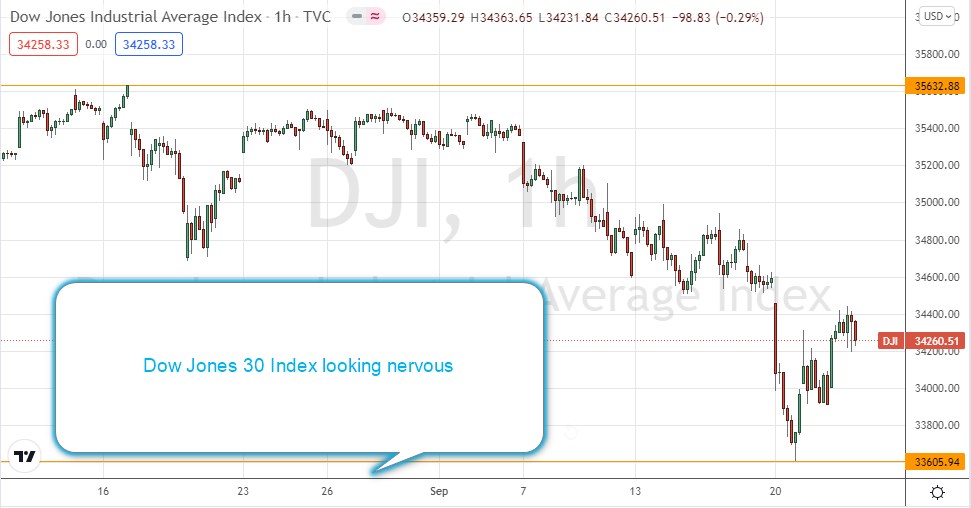FOMC Statement Says Much, Does Little
The US Federal Reserve published its September 2021 FOMC Statement Wednesday and did not actually change anything drastic regarding its current monetary policy. Talk of Fed tapering in the US bond market was addressed, but the US central bank indicated that it is not ready to turn the faucet off quite yet and while it may start to limit purchases in the bond market, it might not be done until the spring of 2022. Gold traded slightly lower yesterday on the news.
Also noteworthy is that the Fed did finally seem to indicate it has a growing concern regarding economic data which suggests inflation may be more than simply transitory, but it did not hike rates. However, it suggested several interest rate hikes may be seen in 2022 and 2023 and these may continue until 2024 as the US economic landscape improves. The major US equity indices rose as a result, with the Dow Jones 30 up by over 300 points yesterday on the Fed’s pronouncements as the day finished.
Federal Reserve’s Smoke and Mirrors Game
Considering the massive amount of federal spending stimulus packages being undertaken by US politicians, while the Federal Reserve says it is pleased with current US economic data, the central bank did very little to address the ‘elephant in the room’. The fact that current US stimulus programs are creating a likely false narrative regarding real gross domestic product is a potentially troubling problem.
While Fed Chairman Jerome Powell pointed to solid economic data, he did little to point to the quantified statistical evidence that without the current amount of stimulus from the US government the past two years that economic data regarding GDP would be lackluster at best. Meaning that while the stock markets did well yesterday and gold floundered, it showed once again the power of cheap money versus the reality of quantified data. In other words, the markets are acting in a confident manner on the words of the Federal Reserve short term, when they probably should be considering getting nervous for the long term.
Smart Money versus Retail Traders
Contrarian investors who are not fond of the US Federal Reserve have reasons to be concerned this morning, because the US central bank continues to seemingly make short sighted decisions without considering data which will play a key role in the coming years. Consumer price index readings regarding inflation remains troubling and wage income growth remains below inflation. The US government can be said to be putting a band aid on an economic injury which needs much more care.
Yes, the US economy remains a solid driver of financial growth and sentiment globally, but there have been signs that a US economic slowdown may be building up a head of steam. This is part of the reason another massive stimulus bill with trillions of dollars is likely being advocated for by the White House, and very few politicians seem to have the courage to say no because they fear a voter backlash.
Retail traders should always remember that institutional financial houses are trying to interpret the moves of the US Federal Reserve before the central bank makes their announcements. In other words, last night’s FOMC Statement had already been acted upon by ‘smart money’ ahead of the pronouncements. It is the retail crowd which is left to deal with the gyrations of market actions which are taking place via programmed trading.
Trading software within the giant financial institutions is set to move depending on quantified data and technical ratios and works with lightning speed. Retail traders should learn to try and eliminate the noise of the market which causes volatility in the short term because they will always find themselves trading in a reactionary manner compared to moves made by institutional financial houses. The short term’s bursts of volatility can be predicted but often proves dangerous, and the fluctuations usually adjust and find their steady long-term path once again after the short-term volatility has ended.
The Federal Reserve surprised almost nobody last night. While the USD was said to become stronger because of the statement by some analysts, the financial markets have been nervous since the first week of September and the USD in Forex has been stronger for a couple of weeks. The core interest rate of the U.S central bank remains near zero, and while sunnier days are promised by the Fed, it is very unlikely they would be eager to predict a storm. If inflation continues to nibble away at the economy, and corporations continue to be dealt commercial woes due to weakening consumer spending, this opens the door to the possibility of something the US Federal Reserve would rather not consider – stagnation.
Final Thoughts
The US Federal Reserve, while saying it will certainly act in the future, leaves the door open to not reacting, because there is a possibility economic circumstances will continue to change and catch the Fed shortsighted. The constant stimulus packages from the US government and parade of cheap money is intended to keep GDP strong and Wall Street competitive with loftier values. Unfortunately, while politicians try to keep everyone happy, the reality is that economic downturns are a natural and healthy part of the economic cycle when they are allowed to be managed with a light hand. By continuing to feed easy money into the US economic system, the medicine at some point may become rather ineffective and the patient may become more ill and harder to ultimately cure when the sickness becomes very dangerous.



